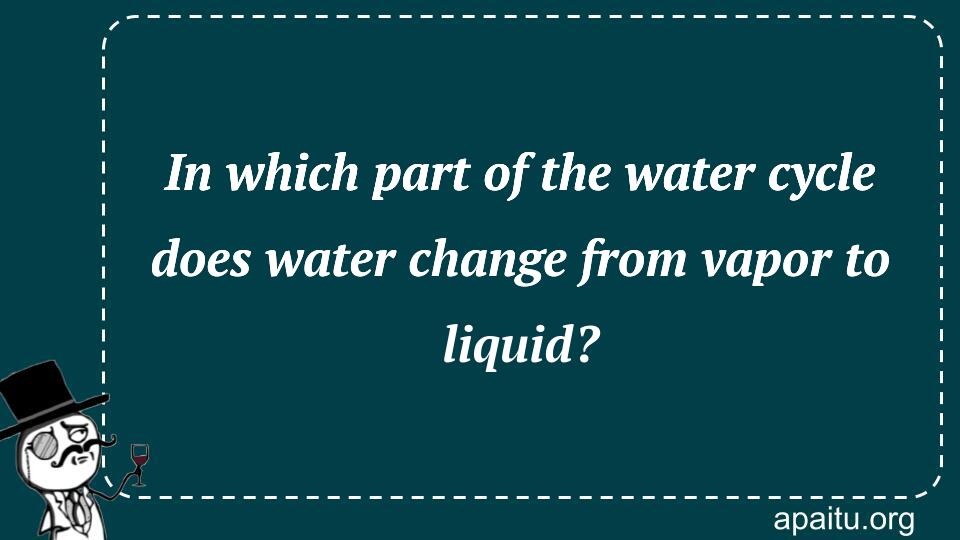Question
Here is the question : IN WHICH PART OF THE WATER CYCLE DOES WATER CHANGE FROM VAPOR TO LIQUID?
Option
Here is the option for the question :
- Evaporation
- Precipitation
- Transpiration
- Condensation
The Answer:
And, the answer for the the question is :
Explanation:
The water cycle is a mechanism that describes how all of the water on Earth is constantly changing form both on the surface and in the atmosphere. Precipitation is the term used to describe the act of water falling as rain, hail, or snow from clouds to the Earth’s surface. The surface of some of this liquid then turns into a vapor, which rises into the atmosphere and condenses into clouds. Condensation is the process by which water changes in the clouds from a vapor to a liquid, starting the cycle all over again.

The Water Cycle: The Transformation from Vapor to Liquid through Condensation
The water cycle, also known as the hydrological cycle, is a continuous process that circulates water throughout the Earth’s atmosphere, surface, and underground. It involves various stages, including evaporation, condensation, precipitation, and runoff. One crucial stage in this cycle is condensation, during which water vapor changes into liquid water. In this article, we explore the phenomenon of condensation, its significance in the water cycle, and its role in shaping our planet’s weather patterns.
Condensation is the process by which water vapor, a gaseous state of water, transforms into liquid water. It occurs when warm air cools down, leading to a decrease in the air’s capacity to hold moisture. As the temperature drops, the water vapor molecules slow down and start to come closer together. This clustering of water molecules results in the formation of tiny water droplets or ice crystals, depending on the temperature.
The formation of water droplets during condensation is a crucial step in the water cycle. It leads to the creation of clouds, which are visible masses of suspended water droplets or ice crystals in the atmosphere. Clouds play a vital role in regulating Earth’s climate by reflecting sunlight back into space and trapping heat, thus influencing the planet’s temperature. Furthermore, clouds are responsible for producing precipitation, such as rain, snow, sleet, or hail, which replenishes the Earth’s surface water.
Condensation occurs when the air becomes saturated with water vapor, meaning it reaches its maximum capacity to hold moisture at a given temperature and pressure. Factors that contribute to the saturation of air include cooling of the air mass, mixing of warm and cold air masses, or the addition of moisture through evaporation from bodies of water. When the air becomes saturated, excess water vapor condenses onto tiny particles called condensation nuclei, such as dust, pollutants, or salt particles, which act as surfaces for water droplets to form.
The formation of dew, fog, and frost are also examples of condensation. Dew forms when the surface temperature of objects, such as grass, leaves, or car windshields, cools down during the night, causing the moisture in the air to condense and collect as droplets on these surfaces. Fog occurs when moist air near the ground is cooled, causing the water vapor to condense into tiny water droplets suspended in the air, reducing visibility. Frost, on the other hand, is created when the temperature drops below freezing, causing water vapor to directly change into ice crystals on surfaces.
Condensation is not only a vital process in the water cycle but also plays a significant role in our daily lives. For example, condensation is responsible for the formation of water droplets on the outside of a cold glass on a hot day, as the cool glass surface causes the moisture in the air to condense. It is also the reason behind the fogging of mirrors after a hot shower, as the warm moisture in the air condenses on the cooler mirror surface.
Understanding condensation is crucial for meteorologists and climatologists as it helps them predict and study weather patterns. By analyzing patterns of condensation and cloud formation, scientists can gain insights into atmospheric conditions, such as humidity, temperature changes, and air movements. This knowledge is essential for weather forecasting, climate modeling, and understanding the impacts of climate change on precipitation patterns.
condensation is a fundamental process in the water cycle, where water vapor transforms into liquid water. It occurs when warm air cools down, leading to the clustering of water molecules and the formation of water droplets or ice crystals. Condensation gives rise to clouds, precipitation, and other atmospheric phenomena, shaping our planet’s weather patterns and regulating its climate. By unraveling the intricacies of condensation, we gain a deeper understanding of the water cycle and its significance in maintaining the delicate balance of our planet’s ecosystems.